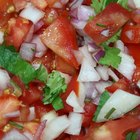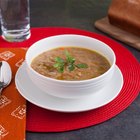
Curry is commercially available in both powder and paste form. The spice consists of several spices combined, most notably turmeric, cumin, coriander, fenugreek and chilis. The exact composition varies among manufacturers, but Indian-type curry powders are often heavier on cardamom, while Thai-style curry seasoning is heavier on chilis and sometimes ginger. Introduce your family to many types of curry to find the flavors that everyone will enjoy.
Create a Base
Curry powder works best when blended with a liquid or semi-liquid prior to adding it to your cooking. If making an Indian curry, whisk your curry powder or paste into plain yogurt. Then add your own seasonings, such as paprika, cardamom or thyme. For Thai curries, use coconut milk instead of yogurt and add garlic, ginger and lemongrass for more flavor. Red curries generally contain more chilis, while a yellow curry relies more on ginger and turmeric.
Balance Spices
Curries need a sweetness to add body to the spice. You can add a little sugar to your recipe, but you'll get a more complex flavor by adding naturally sweet items such as a fruit sauce or juice. Mix this in near the beginning of the cooking process to ensure that the flavors blend thoroughly. Thai-style curries often also include fruit cooked into the dish, such as apples, pineapple, raisins or currants.
Slow, Low Heat
Don't cook your curry over high heat unless you're just using the curry powder as a spice rub for meats. If you're making a more traditional curry, simmer over low or medium-low heat. Brown your meats first, then add your curry sauce and potatoes, if desired. Wait until the meat is cooked through before adding vegetables, especially in Thai curries, so you don't overcook them.
Suggested Ingredients
Along with meat and your seasoning sauce, onions of all kinds work well in any kind of curry. Indian curries are delicious with tomatoes, potatoes, carrots, broccoli, cauliflower and peas, while Thai curries complement bell peppers, basil, green beans, peanuts or cashews, carrots and baby corn. Balance a bowl of spicy curry with a fresh green salad and a cool creamy dressing.
Cooked In or Separate Sauce
Cooking your meats and vegetables directly in the curry sauce is the best way to get the full flavor of your curry dishes. If you have family members who are wary of spices, however, it may be too much to ask them to eat a fully seasoned curry. In this case, cook your meat separately, rubbing curry powder directly onto some pieces of meat for the more adventurous eaters and leaving the rest plain. Then dish as much or as little sauce over the cooked meat as you like, and either cook the veggies in the sauce or separately. When you cook a separate sauce, you have the freedom to overseason it at first, then blend it down with more yogurt or coconut milk until the seasoning is the way you like it.
Related Articles

How to Fix a Sweet Taste in Stews

How to Make Plum Sauce

How to Thicken Chili with Cornmeal

How Do I Thicken Curry?

How Much Turmeric Powder Is in Curry?

How to Get Half & Half to Thicken

What Can Take the Spiciness Out of ...

Quesadilla Spices

How to Make Filipino Pork Adobo

How Can I Make Curry Taste Less Bitter?

What Is a Good Thickening Agent for ...

How to Make Chipotle Sauce

Sources of Calcium in Indian Food

What Is a Good Way to Cook Cubed Pork?

What Herbs Go With Veal Chops?

What Herbs & Spices Flavor Fish?

Herbs & Spices in Lentil Soup

How to Make Fish Taco Sauce

Can You Use Flour to Thicken Chili?
How to Marinate Seitan
References
- "The Joy of Cooking"; I. Rombauer and M. Rombauer Becker; 1973
Writer Bio
Anne Hirsh has been writing and editing for over 10 years. She has hands-on experience in cooking, visual arts and theater as well as writing experience covering wellness and animal-related topics. She also has extensive research experience in marketing, small business, Web development and SEO. Hirsh has a bachelor's degree in technical theater and English and post-baccalaureate training in writing and computer software.
Photo Credits
Jupiterimages/Comstock/Getty Images